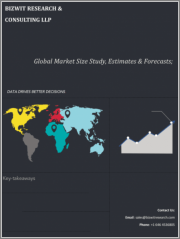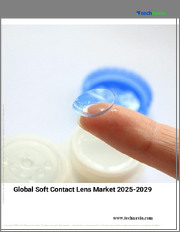
|
시장보고서
상품코드
1381821
세계의 컬러 콘택트렌즈 시장 규모 조사 및 예측 : 유형별, 유통 채널별, 지역별 분석(2023-2030년)Global Colored Contact Market Size study & Forecast, by type (Visibility Tint, Enhancement Tint, Opaque Tint), by Distribution Channel (Optical Stores, Retail Pharmacies, Drugstores, E-commerce) and Regional Analysis, 2023-2030 |
||||||
안질환 유병률의 증가는 컬러 콘택트렌즈를 포함한 렌즈의 수요를 촉진하는 중요한 요인입니다.
또한, 자연스러운 시력을 원하는 소비자의 욕구와 컬러 콘택트렌즈와 관련된 미적 매력도 인기 상승에 기여하고 있습니다. 이 렌즈는 이제 더 저렴해져 중산층을 포함한 더 많은 계층의 사람들이 이용할 수 있게 되었습니다. 과거에는 컬러 콘택트 렌즈는 주로 영화 및 엔터테인먼트 산업에서 사용되었습니다. 그러나 이제는 바람직한 외관과 관련 이점으로 인해 이러한 렌즈에 대한 대중의 수요가 증가하고 있습니다. 컬러 렌즈 시장의 기업들은 예측 기간 동안 이러한 수요 증가를 활용하기 위해서는 품질 기준을 유지하는 것이 매우 중요합니다.
시장 진입 기업들은 E-Commerce 웹사이트, 약국, 소매 약국 등 제3자 플랫폼과 제휴하여 판매 채널을 확장하고 있습니다. 컬러 콘택트렌즈 업체들은 일반적으로 18세에서 40세 사이의 고객을 대상으로 하며, 특히 젊은 세대에 초점을 맞추고 있습니다. 전반적으로 안질환 발생률 증가, 자연스러운 시력에 대한 선호도, 컬러 콘택트렌즈의 미적 가치로 인해 세계 컬러 콘택트렌즈 시장의 성장이 촉진되고 있습니다. 저렴한 가격과 유통 채널의 확대는 더 많은 소비자들이 시장에 접근할 수 있게 하는 데 기여하고 있습니다. 또한 근시 및 부적절한 초점 거리를 포함한 안과 질환의 증가는 시장 성장에 유리한 성장 기회를 제공 할 수 있습니다. 전 세계적으로 약 22억 명의 사람들이 근시 및 원거리 시력 장애를 경험하고 있습니다. 안타깝게도 이 중 절반에 가까운 약 10억 명은 예방할 수 있었거나 아직 제대로 대처하지 못하고 있는 실정입니다.
이 인구 중 시력 장애의 원인은 다양합니다. 그 중 약 8,840만 명이 치료되지 않은 굴절 이상으로 인한 중등도 또는 중증 원거리 시력 장애와 실명으로 고통받고 있습니다. 또한 약 9,400만 명이 백내장으로 인한 시력 장애를 경험하고 있습니다. 약 800만 명이 노화성 황반변성, 약 770만 명이 녹내장을 앓고 있습니다. 또한, 당뇨병성 망막증은 약 390만 명의 시력 장애의 원인이 되고 있습니다. 마지막으로 노안으로 인한 근거리 시력 장애는 약 8억 2,600만 명이 앓고 있는 것으로 추산되며, 상당수의 사람들이 영향을 받고 있습니다.
컬러 콘택트렌즈 세계 시장 조사에서 고려된 주요 지역은 아시아태평양, 북미, 유럽, 라틴아메리카, 중동 및 아프리카입니다. 북미는 트렌드를 적극적으로 따르고 세련된 옵션을 추구하는 인구에 힘입어 현재 컬러 콘택트 렌즈의 지배적인 시장으로 자리 잡고 있습니다. 이 지역의 1인당 소득이 증가함에 따라 렌즈에 돈을 쓸 수 있는 능력도 증가하여 더 다양한 컬러 콘택트렌즈에 대한 수요가 증가하고 있습니다. 유럽은 북미에 이어 두 번째로 큰 컬러 콘택트렌즈 시장이 될 것으로 예상됩니다. 이 지역에서는 정부의 지원, 눈 건강에 대한 대중의 인식 증가, 의료 분야의 정부 자금 지원 증가로 인해 렌즈 벤더가 성장할 가능성이 높습니다.
예측 기간 동안 아시아태평양은 컬러 콘택트렌즈에 대한 중간에서 높은 수요를 보일 것으로 예상됩니다. 이는 주로 이 지역에 패션과 외모에 관심이 많은 젊은 층이 많기 때문입니다. 또한, 이 지역에서는 햇빛에 노출될 기회가 많고 스마트 기기를 장시간 사용하면서 눈과 관련된 문제에 직면하는 사람들이 증가하고 있습니다. 이러한 요인들은 아시아태평양의 컬러 콘택트렌즈 수요 증가에 기여하고 있습니다. 제조업체와 공급업체들은 이 지역 젊은이들의 취향과 니즈에 맞는 다양한 컬러 콘택트렌즈를 제공함으로써 이 시장의 잠재력을 활용할 수 있을 것으로 보입니다.
이 조사의 목적은 최근 몇 년 동안 다양한 부문과 국가의 시장 규모를 정의하고 향후 몇 년 동안의 시장 규모를 예측하는 것입니다. 이 보고서는 조사 대상 국가의 산업의 질적, 양적 측면을 모두 포함하도록 설계되었습니다.
또한 시장의 미래 성장을 규정하는 촉진요인과 과제와 같은 중요한 측면에 대한 자세한 정보도 제공합니다. 또한, 주요 기업의 경쟁 상황과 제품 제공에 대한 상세한 분석과 함께 이해관계자들이 투자할 수 있는 미시적 시장에서의 잠재적 기회도 포함합니다.
목차
제1장 주요 요약
제2장 세계의 컬러 콘택트렌즈 시장 정의와 범위
- 조사 목적
- 시장 정의와 범위
- 업계의 진화
- 조사 범위
- 조사 대상 연도
- 통화 환산율
제3장 컬러 콘택트렌즈 세계 시장 역학
- 컬러 콘택트렌즈 시장의 영향 분석(2020-2030년)
- 시장 성장 촉진요인
- 안질환 증가
- 미용 목적 수요 증가
- 시장 과제
- 위조 렌즈 입수 가능성
- 콘택트렌즈에 따른 알레르기 반응
- 시장 기회
- 기술 진보 증가
- 시장 성장 촉진요인
제4장 컬러 콘택트렌즈 세계 시장 산업 분석
- Porter's 5 Force 모델
- 공급 기업의 교섭력
- 구매자의 교섭력
- 신규 참여업체의 위협
- 대체품의 위협
- 경쟁 기업 간의 경쟁 관계
- Porter's 5 Force 영향 분석
- PEST 분석
- 정치
- 경제
- 사회
- 기술
- 환경
- 법률
- 주요 투자 기회
- 주요 성공 전략
- COVID-19 영향 분석
- 파괴적 동향
- 업계 전문가의 관점
- 애널리스트의 결론과 제안
제5장 컬러 콘택트렌즈 세계 시장 : 유형별
- 시장 현황
- 컬러 콘택트렌즈 세계 시장 : 유형별, 실적 - 잠재성 분석
- 컬러 콘택트렌즈 세계 시장, 유형별, 추정·예측, 2020-2030년
- 컬러 콘택트렌즈 시장, 하위 부문 분석
- 시인형
- 강화형
- 불투명형
제6장 컬러 콘택트렌즈 세계 시장, 유통 채널별
- 시장 현황
- 컬러 콘택트렌즈 세계 시장 : 유통 채널별, 실적 - 잠재성 분석
- 컬러 콘택트렌즈 세계 시장, 유통 채널별, 추정·예측, 2020-2030년
- 컬러 콘택트렌즈 시장, 하위 부문 분석
- 안경점
- 소매 약국
- 드럭스토어
- E-Commerce
제7장 컬러 콘택트렌즈 세계 시장, 지역 분석
- 주요 국가
- 주요 신흥 국가
- 컬러 콘택트렌즈 시장, 지역별 시장 현황
- 북미
- 미국
- 유형별, 추정·예측, 2020-2030년
- 유통 채널, 추정·예측, 2020-2030년
- 캐나다
- 미국
- 유럽의 컬러 콘택트렌즈 시장 현황
- 영국
- 독일
- 프랑스
- 스페인
- 이탈리아
- 기타 유럽
- 아시아태평양의 컬러 콘택트렌즈 시장 현황
- 중국
- 인도
- 일본
- 호주
- 한국
- 기타 아시아태평양
- 라틴아메리카의 컬러 콘택트렌즈 시장 현황
- 브라질
- 멕시코
- 중동 및 아프리카
- 사우디아라비아
- 남아프리카공화국
- 기타 중동 및 아프리카
제8장 경쟁 정보
- 주요 기업 SWOT 분석
- 주요 시장 전략
- 기업 개요
- Alcon
- 주요 정보
- 개요
- 재무(데이터 가용성에 따라 다름)
- 제품 개요
- Johnson & Johnson Vision Care, Inc.(Acuvue)
- Bausch+Lomb
- CooperVision
- Menicon Co., Ltd.
- FreshKon
- Ciba Vision(now part of Alcon)
- NEO Vision
- Geo Medical
- TTDeye
- Alcon
제9장 조사 과정
- 조사 과정
- 데이터 광업
- 분석
- 시장 추정
- 검증
- 출판
- 조사 속성
- 조사 가정
The increasing prevalence of eye disorders is a significant factor driving the demand for lenses, including colored contact lenses. Additionally, consumers' desire for natural vision and the aesthetic appeal associated with colored contact lenses contribute to their growing popularity. These lenses are now more affordable, enabling a wider range of individuals, including the middle class, to access them. Previously, colored contact lenses were predominantly used in the film and entertainment industry. However, there is now a rising demand for these lenses from the public due to their desired appearance and associated benefits. It is crucial for companies in the colored lens market to maintain quality standards to capitalize on this growing demand during the forecast period.
Market players are expanding their distribution channels by partnering with third-party platforms such as e-commerce websites, drug stores, and retail pharmacies. Colored contact lens vendors typically target customers between the ages of 18 and 40, with a particular focus on the younger generation. Overall, the rising incidence of eye disorders, the preference for natural vision, and the aesthetic value of colored contact lenses are driving the growth of the global colored contact lenses market. Affordable pricing and expanded distribution channels contribute to the market's accessibility to a wider range of consumers. Moreover, growing eye disorders including myopia and improper focal length may offer lucrative growth opportunities for the market growth. Globally, there is a significant number of people, approximately 2.2 billion, who experience near or distant vision impairments. Alarmingly, nearly half of these cases, involving around 1 billion individuals, could have been prevented or have not yet been properly addressed.
Within this population, there are various causes of vision impairment. Among them, approximately 88.4 million people suffer from moderate or severe distance vision impairment or blindness due to unaddressed refractive error. Additionally, around 94 million individuals experience vision impairment caused by cataracts. Age-related macular degeneration affects approximately 8 million people, while glaucoma affects approximately 7.7 million people. Moreover, diabetic retinopathy contributes to vision impairment for around 3.9 million individuals. Lastly, near vision impairment resulting from unaddressed presbyopia affects a significant number of people, with an estimated 826 million individuals being affected.
The key regions considered for the Global Colored Contact Market study include Asia Pacific, North America, Europe, Latin America, and Middle East & Africa. North America is currently the dominant market for colored contact lenses, driven by a population that actively follows trends and seeks fashionable options. The region's increasing per-person income has also contributed to the ability to spend on lenses, resulting in a higher demand for a wider variety of colored contact lenses. Following North America, Europe is expected to emerge as the second-largest market for colored contact lenses. The region is likely to see a growth in lens vendors due to favorable government support, rising public awareness about eye health, and increased funding by governments in the healthcare sector.
In the forecast period, the Asia Pacific region is anticipated to experience moderate to high demand for colored contact lenses. This is primarily due to the large youth population in the region, who are enthusiastic about fashion and personal appearance. Additionally, the region has witnessed an increase in the number of individuals facing eye-related issues, partly attributed to greater exposure to sunlight and prolonged use of smart devices. These factors contribute to the growing demand for colored contact lenses in the Asia Pacific region. Manufacturers and vendors are likely to capitalize on this market potential by offering a diverse range of colored contact lenses that cater to the preferences and needs of the youth population in the region.
Major market player included in this report are:
- Alcon
- Johnson & Johnson Vision Care, Inc. (Acuvue)
- Bausch + Lomb
- CooperVision
- Menicon Co., Ltd.
- FreshKon
- Ciba Vision (now part of Alcon)
- NEO Vision
- Geo Medical
- TTDeye
Recent Developments in the Market:
- Johnson & Johnson has become the top manufacturer of contact lenses by introducing cutting-edge eye lenses such as multifocal fit for pupil size, intraocular lenses for digital world comfort, and personalised solutions for client comfort.
Global Colored Contact Market Report Scope:
- Historical Data - 2020 - 2021
- Base Year for Estimation - 2022
- Forecast period - 2023-2030
- Report Coverage - Revenue forecast, Company Ranking, Competitive Landscape, Growth factors, and Trends
- Segments Covered - Type, Distribution Channel, Region
- Regional Scope - North America; Europe; Asia Pacific; Latin America; Middle East & Africa
- Customization Scope - Free report customization (equivalent up to 8 analyst's working hours) with purchase. Addition or alteration to country, regional & segment scope*
The objective of the study is to define market sizes of different segments & countries in recent years and to forecast the values to the coming years. The report is designed to incorporate both qualitative and quantitative aspects of the industry within countries involved in the study.
The report also caters detailed information about the crucial aspects such as driving factors & challenges which will define the future growth of the market. Additionally, it also incorporates potential opportunities in micro markets for stakeholders to invest along with the detailed analysis of competitive landscape and product offerings of key players. The detailed segments and sub-segment of the market are explained below:
By Type:
- Visibility Tint
- Enhancement Tint
- Opaque Tint
By Distribution Channel:
- Optical Stores
- Retail Pharmacies
- Drugstores
- E-commerce
By Region:
- North America
- U.S.
- Canada
- Europe
- UK
- Germany
- France
- Spain
- Italy
- ROE
- Asia Pacific
- China
- India
- Japan
- Australia
- South Korea
- RoAPAC
- Latin America
- Brazil
- Mexico
- Middle East & Africa
- Saudi Arabia
- South Africa
- Rest of Middle East & Africa
Table of Contents
Chapter 1. Executive Summary
- 1.1. Market Snapshot
- 1.2. Global & Segmental Market Estimates & Forecasts, 2020-2030 (USD Billion)
- 1.2.1. Coloured Contact Lenses Market, by Region, 2020-2030 (USD Billion)
- 1.2.2. Coloured Contact Lenses Market, by Type, 2020-2030 (USD Billion)
- 1.2.3. Coloured Contact Lenses Market, by Distribution Channel, 2020-2030 (USD Billion)
- 1.3. Key Trends
- 1.4. Estimation Methodology
- 1.5. Research Assumption
Chapter 2. Global Coloured Contact Lenses Market Definition and Scope
- 2.1. Objective of the Study
- 2.2. Market Definition & Scope
- 2.2.1. Industry Evolution
- 2.2.2. Scope of the Study
- 2.3. Years Considered for the Study
- 2.4. Currency Conversion Rates
Chapter 3. Global Coloured Contact Lenses Market Dynamics
- 3.1. Coloured Contact Lenses Market Impact Analysis (2020-2030)
- 3.1.1. Market Drivers
- 3.1.1.1. Rising incidences of eye disorders
- 3.1.1.2. Growing demand for cosmetic enhancements
- 3.1.2. Market Challenges
- 3.1.2.1. Availability of counterfeit lens
- 3.1.2.2. Allergic reaction associated with contact lenses.
- 3.1.3. Market Opportunities
- 3.1.3.1. Increasing technological Advancements
- 3.1.1. Market Drivers
Chapter 4. Global Coloured Contact Lenses Market Industry Analysis
- 4.1. Porter's 5 Force Model
- 4.1.1. Bargaining Power of Suppliers
- 4.1.2. Bargaining Power of Buyers
- 4.1.3. Threat of New Entrants
- 4.1.4. Threat of Substitutes
- 4.1.5. Competitive Rivalry
- 4.2. Porter's 5 Force Impact Analysis
- 4.3. PEST Analysis
- 4.3.1. Political
- 4.3.2. Economical
- 4.3.3. Social
- 4.3.4. Technological
- 4.3.5. Environmental
- 4.3.6. Legal
- 4.4. Top investment opportunity
- 4.5. Top winning strategies
- 4.6. COVID-19 Impact Analysis
- 4.7. Disruptive Trends
- 4.8. Industry Expert Perspective
- 4.9. Analyst Recommendation & Conclusion
Chapter 5. Global Coloured Contact Lenses Market, by Type
- 5.1. Market Snapshot
- 5.2. Global Coloured Contact Lenses Market by Type, Performance - Potential Analysis
- 5.3. Global Coloured Contact Lenses Market Estimates & Forecasts by Type 2020-2030 (USD Billion)
- 5.4. Coloured Contact Lenses Market, Sub Segment Analysis
- 5.4.1. Visibility Tint
- 5.4.2. Enhancement Tint
- 5.4.3. Opaque Tint
Chapter 6. Global Coloured Contact Lenses Market, by Distribution Channel
- 6.1. Market Snapshot
- 6.2. Global Coloured Contact Lenses Market by Distribution Channel, Performance - Potential Analysis
- 6.3. Global Coloured Contact Lenses Market Estimates & Forecasts by Distribution Channel 2020-2030 (USD Billion)
- 6.4. Coloured Contact Lenses Market, Sub Segment Analysis
- 6.4.1. Optical Stores
- 6.4.2. Retail Pharmacies
- 6.4.3. Drugstores
- 6.4.4. E-commerce
Chapter 7. Global Coloured Contact Lenses Market, Regional Analysis
- 7.1. Top Leading Countries
- 7.2. Top Emerging Countries
- 7.3. Coloured Contact Lenses Market, Regional Market Snapshot
- 7.4. North America Coloured Contact Lenses Market
- 7.4.1. U.S. Coloured Contact Lenses Market
- 7.4.1.1. Type breakdown estimates & forecasts, 2020-2030
- 7.4.1.2. Distribution Channel breakdown estimates & forecasts, 2020-2030
- 7.4.1.3. ijkl breakdown estimates & forecasts, 2020-2030
- 7.4.1.4. xyz breakdown estimates & forecasts, 2020-2030
- 7.4.2. Canada Coloured Contact Lenses Market
- 7.4.1. U.S. Coloured Contact Lenses Market
- 7.5. Europe Coloured Contact Lenses Market Snapshot
- 7.5.1. U.K. Coloured Contact Lenses Market
- 7.5.2. Germany Coloured Contact Lenses Market
- 7.5.3. France Coloured Contact Lenses Market
- 7.5.4. Spain Coloured Contact Lenses Market
- 7.5.5. Italy Coloured Contact Lenses Market
- 7.5.6. Rest of Europe Coloured Contact Lenses Market
- 7.6. Asia-Pacific Coloured Contact Lenses Market Snapshot
- 7.6.1. China Coloured Contact Lenses Market
- 7.6.2. India Coloured Contact Lenses Market
- 7.6.3. Japan Coloured Contact Lenses Market
- 7.6.4. Australia Coloured Contact Lenses Market
- 7.6.5. South Korea Coloured Contact Lenses Market
- 7.6.6. Rest of Asia Pacific Coloured Contact Lenses Market
- 7.7. Latin America Coloured Contact Lenses Market Snapshot
- 7.7.1. Brazil Coloured Contact Lenses Market
- 7.7.2. Mexico Coloured Contact Lenses Market
- 7.8. Middle East & Africa Coloured Contact Lenses Market
- 7.8.1. Saudi Arabia Coloured Contact Lenses Market
- 7.8.2. South Africa Coloured Contact Lenses Market
- 7.8.3. Rest of Middle East & Africa Coloured Contact Lenses Market
Chapter 8. Competitive Intelligence
- 8.1. Key Company SWOT Analysis
- 8.1.1. Company 1
- 8.1.2. Company 2
- 8.1.3. Company 3
- 8.2. Top Market Strategies
- 8.3. Company Profiles
- 8.3.1. Alcon
- 8.3.1.1. Key Information
- 8.3.1.2. Overview
- 8.3.1.3. Financial (Subject to Data Availability)
- 8.3.1.4. Product Summary
- 8.3.1.5. Recent Developments
- 8.3.2. Johnson & Johnson Vision Care, Inc. (Acuvue)
- 8.3.3. Bausch + Lomb
- 8.3.4. CooperVision
- 8.3.5. Menicon Co., Ltd.
- 8.3.6. FreshKon
- 8.3.7. Ciba Vision (now part of Alcon)
- 8.3.8. NEO Vision
- 8.3.9. Geo Medical
- 8.3.10. TTDeye
- 8.3.1. Alcon
Chapter 9. Research Process
- 9.1. Research Process
- 9.1.1. Data Mining
- 9.1.2. Analysis
- 9.1.3. Market Estimation
- 9.1.4. Validation
- 9.1.5. Publishing
- 9.2. Research Attributes
- 9.3. Research Assumption

















